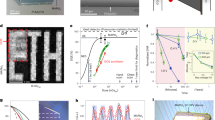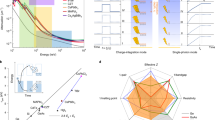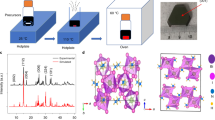Abstract
The evolution of real-time medical diagnostic tools such as angiography and computer tomography from radiography based on photographic plates was enabled by the development of integrated solid-state X-ray photon detectors made from conventional solid-state semiconductors. Recently, for optoelectronic devices operating in the visible and near-infrared spectral regions, solution-processed organic and inorganic semiconductors have also attracted a great deal of attention. Here, we demonstrate a possibility to use such inexpensive semiconductors for the sensitive detection of X-ray photons by direct photon-to-current conversion. In particular, methylammonium lead iodide perovskite (CH3NH3PbI3) offers a compelling combination of fast photoresponse and a high absorption cross-section for X-rays, owing to the heavy Pb and I atoms. Solution-processed photodiodes as well as photoconductors are presented, exhibiting high values of X-ray sensitivity (up to 25 μC mGyair−1 cm−3) and responsivity (1.9 × 104 carriers/photon), which are commensurate with those obtained by the current solid-state technology.
This is a preview of subscription content, access via your institution
Access options
Subscribe to this journal
Receive 12 print issues and online access
$209.00 per year
only $17.42 per issue
Buy this article
- Purchase on Springer Link
- Instant access to full article PDF
Prices may be subject to local taxes which are calculated during checkout



Similar content being viewed by others
References
Tegze, M. & Faigel, G. X-ray holography with atomic resolution. Nature 380, 49–51 (1996).
Shanmugam, M. et al. Alpha particle X-ray spectrometer (APXS) on-board Chandrayaan-2 rover. Adv. Space Res. 54, 1974–1984 (2014).
Yaffe, M. J. & Rowlands, J. A. X-ray detectors for digital radiography. Phys. Med. Biol. 42, 1–39 (1997).
Kasap, S. O. & Rowlands, J. A. Direct-conversion flat-panel X-ray image sensors for digital radiography. Proc. IEEE 90, 591–604 (2002).
Moy, J. P. Recent developments in X-ray imaging detectors. Nucl. Instrum. Meth. Phys. Res. 442, 26–37 (2000).
Zhao, W. & Rowlands, J. A. X-ray imaging using amorphous selenium: feasibility of a flat panel self-scanned detector for digital radiology. J. Med. Phys. 22, 1595–1604 (1995).
Oh, K. M. et al. Measurement of the electrical properties of a polycrystalline cadmium telluride for direct conversion flat panel X-ray detector. J. Instrum. 9, P01010 (2014).
Kasap, S. et al. Amorphous and polycrystalline photoconductors for direct conversion flat panel X-ray image sensors. Sensors 11, 5112–5157 (2011).
Halls, J. J. M. et al. Efficient photodiodes from interpenetrating polymer networks. Nature 376, 498–500 (1995).
Konstantatos, G. et al. Ultrasensitive solution-cast quantum dot photodetectors. Nature 442, 180–183 (2006).
Keuleyan, S., Lhuillier, E., Brajuskovic, V. & Guyot-Sionnest, P. Mid-infrared HgTe colloidal quantum dot photodetectors. Nature Photon. 5, 489–493 (2011).
Rauch, T. et al. Near-infrared imaging with quantum-dot-sensitized organic photodiodes. Nature Photon. 3, 332–336 (2009).
Chung, I., Lee, B., He, J., Chang, R. P. & Kanatzidis, M. G. All-solid-state dye-sensitized solar cells with high efficiency. Nature 485, 486–489 (2012).
Gratzel, M. The light and shade of perovskite solar cells. Nature Mater. 13, 838–842 (2014).
Green, M. A., Ho-Baillie, A. & Snaith, H. J. The emergence of perovskite solar cells. Nature Photon. 8, 506–514 (2014).
Im, J. H., Jang, I. H., Pellet, N., Gratzel, M. & Park, N. G. Growth of CH3NH3PbI3 cuboids with controlled size for high-efficiency perovskite solar cells. Nature Nanotech. 9, 927–932 (2014).
Jeon, N. J. et al. Compositional engineering of perovskite materials for high-performance solar cells. Nature 517, 476–480 (2015).
Zhou, H. et al. Interface engineering of highly efficient perovskite solar cells. Science 345, 542–546 (2014).
Tan, Z. K. et al. Bright light-emitting diodes based on organometal halide perovskite. Nature Nanotech. 9, 687–692 (2014).
Xing, G. et al. Low-temperature solution-processed wavelength-tunable perovskites for lasing. Nature Mater. 13, 476–480 (2014).
Dou, L. et al. Solution-processed hybrid perovskite photodetectors with high detectivity. Nature Commun. 5, 5404 (2014).
Grodstein, G. W. X-ray Attenuation Coefficients from 10 keV to 100 MeV (US Department of Commerce, National Bureau of Standards, 1957).
Stranks, S. D. et al. Electron–hole diffusion lengths exceeding 1 micrometer in an organometal trihalide perovskite absorber. Science 342, 341–344 (2013).
Wehrenfennig, C., Eperon, G. E., Johnston, M. B., Snaith, H. J. & Herz, L. M. High charge carrier mobilities and lifetimes in organolead trihalide perovskites. Adv. Mater. 26, 1584–1589 (2014).
Xing, G. et al. Long-range balanced electron- and hole-transport lengths in organic–inorganic CH3NH3PbI3 . Science 342, 344–347 (2013).
Baikie, T. et al. Synthesis and crystal chemistry of the hybrid perovskite (CH3NH3) PbI3 for solid-state sensitised solar cell applications. J. Mater. Chem. A 1, 5628–5641 (2013).
Kasap, S. O. X-ray sensitivity of photoconductors: application to stabilized a-Se. J. Phys. D 33, 2853–2865 (2000).
Schieber, M. et al. Thick films of X-ray polycrystalline mercuric iodide detectors. J. Cryst. Growth 225, 118–123 (2001).
Juška, G. & Arlauskas, K. Impact ionization and mobilities of charge carriers at high electric fields in amorphous selenium. Phys. Status Solidi A 59, 389–393 (1980).
Street, R. A. et al. Comparison of PbI2 and HgI2 for direct detection active matrix X-ray image sensors. J. Appl. Phys. 91, 3345–3355 (2002).
Kabir, M. Z. & Kasap, S. O. Charge collection and absorption-limited sensitivity of X-ray photoconductors: applications to a-Se and HgI2 . Appl. Phys. Lett. 80, 1664–1666 (2002).
Masuzawa, T. et al. Development of an amorphous selenium-based photodetector driven by a diamond cold cathode. Sensors 13, 13744–13778 (2013).
Nie, W. et al. High-efficiency solution-processed perovskite solar cells with millimeter-scale grains. Science 347, 522–525 (2015).
Yakunin, S. et al. High infrared photoconductivity in films of arsenic-sulfide-encapsulated lead-sulfide nanocrystals. ACS Nano 8, 12883–12894 (2014).
Acknowledgements
The authors acknowledge the Austrian Science Fund FWF for financial support through the SFB project IR_ON. A part of the research was also performed at the Energie Campus Nürnberg and supported by funding through the ‘Aufbruch Bayern’ initiative of the state of Bavaria. M.K. and S.Y. acknowledge partial financial support from the European Union through the FP7 (ERC Starting Grant NANOSOLID, GA no. 306733). The authors thank V. Sassi, S. Roters, E. Nusko, W. Grafeneder and M. Bodnarchuk for technical assistance. S.Y. thanks M. Hardman for assisting with the selection of plants for X-ray imaging. The authors thank N. Stadie for reading the manuscript.
Author information
Authors and Affiliations
Contributions
The manuscript was prepared with contributions from all authors. S.Y., M.S., D.K. and J.S. performed the work with the photoconductors. S.S., H.A., G.M. and M.R. prepared and tested the solar cell devices. W.H., G.M., C.B. and M.K. planned and supervised the work and had major input in the writing of the manuscript.
Corresponding author
Ethics declarations
Competing interests
The authors declare no competing financial interests.
Supplementary information
Supplementary information
Supplementary information (PDF 946 kb)
Rights and permissions
About this article
Cite this article
Yakunin, S., Sytnyk, M., Kriegner, D. et al. Detection of X-ray photons by solution-processed lead halide perovskites. Nature Photon 9, 444–449 (2015). https://doi.org/10.1038/nphoton.2015.82
Received:
Accepted:
Published:
Issue Date:
DOI: https://doi.org/10.1038/nphoton.2015.82
This article is cited by
-
Cation-π interactions enabled water-stable perovskite X-ray flat mini-panel imager
Nature Communications (2024)
-
Anisotropic carrier dynamics and laser-fabricated luminescent patterns on oriented single-crystal perovskite wafers
Nature Communications (2024)
-
Hybrid Metal Halide Perovskite–Graphene Sensor for Ultra-sensitive X-ray Detection
Arabian Journal for Science and Engineering (2024)
-
Metal Halide Perovskite for next-generation optoelectronics: progresses and prospects
eLight (2023)
-
Optical anisotropy of CsPbBr3 perovskite nanoplatelets
Nano Convergence (2023)



